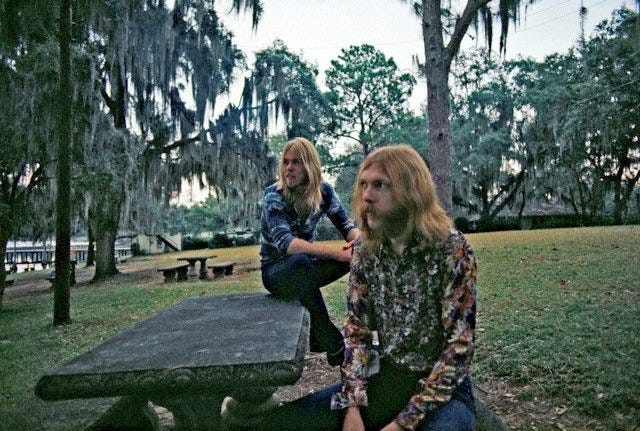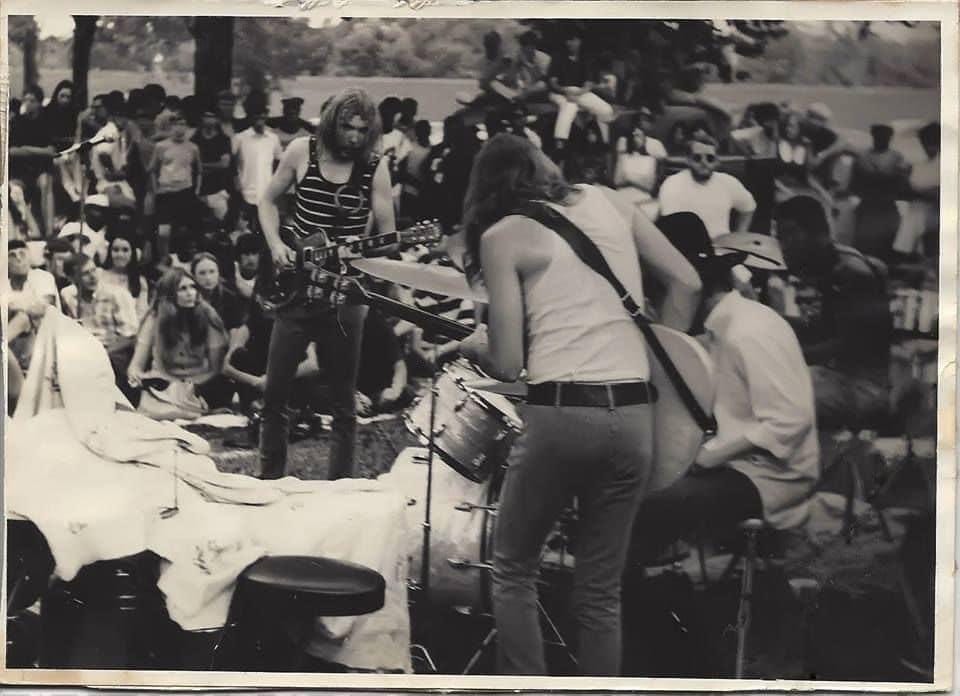Dreams
“Dreams” is the Allman Brothers Band song that grabbed me first.
Listening to it evoked this image of Duane and Gregg sitting at a mildew-stained concrete park bench, Spanish moss on the trees. It screamed THE SOUTH to me. It was the Florida I grew up in, as had Duane and Gregg and Butch and Dickey.
“Dreams” is peak Allman Brothers
I spent a significant amount of time breaking down the development of the Allman Brothers’ sound when I wrote Play All Night! Duane Allman & the Journey to Fillmore East.1
I listened with intentionality to make sense of how songs grew and developed.
My favorite song in the canon2, “Dreams” was the first of two Gregg songs they worked up when Gregg arrived to join the band in Jacksonville. (The other was “It’s Not My Cross to Bear.”)3
On An Evening with the Allman Brothers Band First Set (1992), Gregg joked “Dreams” was “the only song I had with me when I showed up to join the band.”
It was more like song 20 that he’d showed them; it was the first the band liked.
They quickly revamped Gregg’s ballad. Using Miles Davis’s “All Blues” as a model, the band changed the tempo from 4/4 time to 6/84 and emphasized the verse’s 2-chord vamp for Duane’s extended solo.
It was a stalwart of the repertoire from the very beginning
For this reason, “Dreams” has a really strong recorded lineage.
A 1969 demo from Macon first appeared on the Dreams box set. It’s brief and Duane has yet to start playing slide on the cut. Dickey uses the wah-wah on rhythm but other than that, the song is pretty close to what we know today.
That same weekend, the band played “Dreams” at a free gig in Macon’s Central City Park, May 4, 1969.5
In August 1969 at Atlantic Recording Studios, NYC, the band recorded the version that’s on the debut album. (What hooked me when I first heard it on Decade of Hits 20+ years later.6)
Gregg’s ethereal B3 playing7 fits the existential themes of the lyrics.8
Duane’s solo feels urgent, yet restrained. He builds energy toward the redemption of the second verse. Four profound, powerfully simple statements.
“Pull myself together.
Put on a new face.
Climb down off the hilltop.
Get back in the race.”
Here’s Butch (to Alan Paul) on Duane’s solo.
The only thing we got stuck on wound up being the high point of that whole record: Duane's solo on “Dreams.” We tried playing it several times and couldn't get it…. Finally, he said, “Let's not waste any more time. Let's record the song and leave a good long opening for me to solo.”
We were just jamming to give him some movement to play along with, and he was playing rhythm, leading us where he wanted to go….
One night, we had finished what we were doing and he said, “Turn off all the lights,” and he went way to the back corner, where his amp and baffle were, and sat down—on the floor, I think—and they rolled the track and he started playing that solo that's on the record.
All of a sudden he was playing slide, which he had never done on the song before. He said that he just saw the slide sitting there, stuck it on, and played a lot of the same licks he had played, redone with the slide.
Then he got to the end and started that rolling lick and built to an incredible climax. By the time he finished everybody in there was in tears. It was unbelievable.
I still have a hard time listening to that solo without getting emotional. It was just magic.9
I feel those last lines. I’m guessing you might too.
There’s just something about “Dreams.” It’s the most complete song on the record. (By “complete,” I mean the song that sounds the most like the uniqueness of the Allman Brothers Band.10)
At a little over 7 minutes long, it incorporates everything that makes the Allman Brothers Band unique: Gregg’s vocals, his haunting B3, Oakley’s walking bassline, pocket-perfect drums11, and Duane’s GLORIOUS 3-minute solo, fretted and on slide.
Dickey and Dreams
“Dreams” was a regular part of the repertoire in 1969-70.
Dickey never soloed on the song in those years but laid down some of my ABBsolute favorite rhythm playing throughout 1970.
Which is kind of funny considering Dickey did not play on the studio version of “Dreams.”
Dickey was frustrated with the environment, Gregg wrote.
He finally packed up his guitar, didn’t say a thing, and walked out. Butch stood up and said, “What in the hell is he doing?”
“Just leave him alone,” Duane said.
I couldn’t see what the turn-off was for him, but maybe Dickey was such a country boy that at first the studio technology was too much for him.
Duane played all the guitar that you hear on “Dreams.”12
Gregg’s assessment was spot-on. Dickey called the studio “a padded cell” and carried contempt for studios for years thereafter.
“A prostitution of music,” he said. “You been out playing in bars, then you go into concerts, and it’s always the raw communication between people. But here you are in this tin can with a bunch of machines all around you, and you’re expected to produce.”13
The ABB played “Dreams” extensively throughout 1970
It’s on two official releases: the April 1970 Ludlow Garage set14 and Atlanta Pop Festival, from July 3, 1970.
Two other favorites are 7/9/70 and 7/10/70 SUNY Stonybrook. I believe these are the only times we have “Dreams” from back-to-back nights. (Of course Stonybrook is also the site of the epic “Dreams to End All Dreams” from 9/19/71.)
“Dreams” drops out of the set for most of 1971
In early 1971, “Dreams” pretty much fell out of the setlist as the group rehearsed for At Fillmore East. They played it twice at Fillmore West in January and on 2/28/71 at Brewer Fieldhouse, Columbia, MO. And that’s it until it shows up again 9/19/71 at Stonybrook.
They didn’t play it once the weekend they recorded At Fillmore East.
It’s my only complaint about the album.
Why? It’s clearly one of their best songs and also a fan favorite.15
It’s anyone’s guess why they didn’t play it that weekend but I genuinely believe Duane was satisfied with the studio recording of the track. Butch’s account of the recording confirms this to me.
Duane knew he nailed the song and the band needed to work on other tracks for their make-or-break third album.
As spring turned to summer 1971, the Allman Brothers Band played songs they needed to have right when they arrived for the live sessions.
They continued to play that setlist for the rest of the year, promoting what became a massive hit album, At Fillmore East.16
Given the success of the album, it was probably a wise decision, but I’d kill for one of those brilliant Tom Dowd recordings of my favorite song in the canon.
RANDOM NOTES
“Dreams” rejoined the setlist in 1989
The ABB revived the song for the 1989 Dreams reunion, where it remained for the next 25 years. A revamped arrangement allowed Dickey a fretted solo, with Warren Haynes playing the slide solo. This continued when Jack Pearson and Derek Trucks played with Dickey. Derek took both solos in Summer 2000. He and Haynes switched off after Warren rejoined the band.
Let’s talk about that B3
Gregg gets short shrift, and always has as a keyboard player. He might not have been the virtuoso on the Hammond that Duane was on guitar or Berry was on bass, but he could bring it.
Gregg often called his playing the gravy on top of the meat. In this case, it’s the whole foundation for everything: Gregg hanging on the two chords of the verse: C and D, with an occasional Em thrown in for good measure.17
It’s beautiful and fits so perfectly with what else is going on.
“Dreams” Playlist for Paid Subscribers
For my paid subscribers, I created a playlist of the tracks above and a few more for good measure. It is far from comprehensive and there are versions I prefer that aren’t on YT. I included versions from every era of the band but the Dickey/Derek lineup and only because I haven’t tracked one down yet)
Thanks for reading.
Keep reading with a 7-day free trial
Subscribe to Long Live the ABB: Conversation from the Crossroads to keep reading this post and get 7 days of free access to the full post archives.




